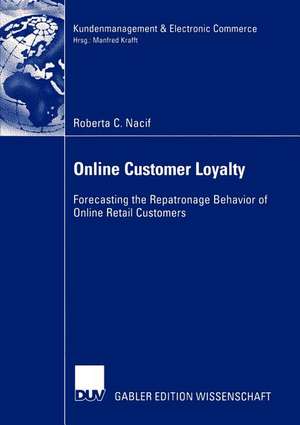Online Customer Loyalty: Forecasting the Repatronage Behavior of Online Retail Customers: Kundenmanagement & Electronic Commerce
Autor Roberta C. Nacifen Limba Engleză Paperback – 26 noi 2003
Din seria Kundenmanagement & Electronic Commerce
- 15%
 Preț: 445.11 lei
Preț: 445.11 lei - 15%
 Preț: 487.90 lei
Preț: 487.90 lei - 15%
 Preț: 440.21 lei
Preț: 440.21 lei - 15%
 Preț: 441.83 lei
Preț: 441.83 lei - 15%
 Preț: 440.02 lei
Preț: 440.02 lei - 15%
 Preț: 466.31 lei
Preț: 466.31 lei - 15%
 Preț: 471.53 lei
Preț: 471.53 lei -
 Preț: 491.21 lei
Preț: 491.21 lei -
 Preț: 487.19 lei
Preț: 487.19 lei - 15%
 Preț: 589.14 lei
Preț: 589.14 lei -
 Preț: 451.26 lei
Preț: 451.26 lei - 15%
 Preț: 524.70 lei
Preț: 524.70 lei -
 Preț: 485.99 lei
Preț: 485.99 lei - 15%
 Preț: 442.48 lei
Preț: 442.48 lei - 15%
 Preț: 442.17 lei
Preț: 442.17 lei -
 Preț: 486.80 lei
Preț: 486.80 lei - 15%
 Preț: 445.11 lei
Preț: 445.11 lei - 15%
 Preț: 443.96 lei
Preț: 443.96 lei - 15%
 Preț: 442.17 lei
Preț: 442.17 lei - 15%
 Preț: 471.87 lei
Preț: 471.87 lei - 15%
 Preț: 500.26 lei
Preț: 500.26 lei -
 Preț: 489.48 lei
Preț: 489.48 lei - 15%
 Preț: 441.69 lei
Preț: 441.69 lei -
 Preț: 451.73 lei
Preț: 451.73 lei - 15%
 Preț: 471.53 lei
Preț: 471.53 lei -
 Preț: 381.43 lei
Preț: 381.43 lei - 15%
 Preț: 468.76 lei
Preț: 468.76 lei -
 Preț: 487.96 lei
Preț: 487.96 lei
Preț: 641.85 lei
Preț vechi: 755.13 lei
-15% Nou
Puncte Express: 963
Preț estimativ în valută:
122.81€ • 128.59$ • 101.87£
122.81€ • 128.59$ • 101.87£
Carte tipărită la comandă
Livrare economică 09-23 aprilie
Preluare comenzi: 021 569.72.76
Specificații
ISBN-13: 9783824479108
ISBN-10: 3824479109
Pagini: 384
Ilustrații: XXII, 361 p. 1 illus.
Dimensiuni: 148 x 210 x 20 mm
Greutate: 0.46 kg
Ediția:Softcover reprint of the original 1st ed. 2003
Editura: Deutscher Universitätsverlag
Colecția Deutscher Universitätsverlag
Seria Kundenmanagement & Electronic Commerce
Locul publicării:Wiesbaden, Germany
ISBN-10: 3824479109
Pagini: 384
Ilustrații: XXII, 361 p. 1 illus.
Dimensiuni: 148 x 210 x 20 mm
Greutate: 0.46 kg
Ediția:Softcover reprint of the original 1st ed. 2003
Editura: Deutscher Universitätsverlag
Colecția Deutscher Universitätsverlag
Seria Kundenmanagement & Electronic Commerce
Locul publicării:Wiesbaden, Germany
Public țintă
ResearchCuprins
1 Introduction.- 1.1 Problem description.- 1.2 Research Aim.- 1.3 Structure of the Thesis.- 2 Conceptual Foundations.- 2.1 Service Encounters.- 2.2 Self-service Technology Research.- 2.3 The Internet as a Self-service Technology.- 3 Concept and Importance of Repatronage Decisions.- 4 Conceptual Development of a Repatronage Decision Framework.- 4.1 Relational Market Behavior: Analysis of the Customer Perspective.- 4.2 Relevant Theoretical Concepts.- 4.3 Repatronage Decision Modelling: Analysis of Antecedents.- 4.4 Summary of Hypotheses.- 5 Repatronage Decisions as an Empirical Problem.- 5.1 The Study Design.- 5.2 Operationalization and Measurement of Constructs.- 5.3 Model Estimation and Results.- 5.4 Discussion of Empirical Findings.- 6 Conclusion.- 6.1 Summary of Findings.- 6.2 Managerial Implications.- 6.3 Limitations and Future Research Directions.- A Internet Statistics.- B Questionnaire.- C Comparison Between Groups.- References.
Notă biografică
Dr. Roberta C. Nacif promovierte bei Prof. Dr. Manfred Krafft am Lehrstuhl für Marketing der Wissenschaftlichen Hochschule für Unternehmensführung (WHU) in Vallendar. Sie ist als Strategy Consultant mit dem Schwerpunkt Einsatz quantitativer Methoden im Marketing tätig.
Textul de pe ultima copertă
Technology is changing the way customers and companies interact. How consumer purchasing behavior is affected by the use of technologies which enable them to purchase independently of direct service employee contact - i.e., by shopping via a technological interface rather than in a brick-and-mortar shop - is of great interest to corporations.
Roberta C. Nacif investigates the behavioral consequences of self-service purchases when consumers shop via the Internet. She explores the effects that customers' assessments of service encounters experiences (attitudes) and transactional history (prior behavior) have on their subsequent purchase behavior. She analyzes two aspects of repurchase behavior: customers' decision of whether or not to repurchase from the same retailer and customers' decision about how much money to spend. The author develops a framework describing the motivations of customers to engage in relational market behavior and tests this framework with individualized customer data obtained from a major European online retailer.
Roberta C. Nacif investigates the behavioral consequences of self-service purchases when consumers shop via the Internet. She explores the effects that customers' assessments of service encounters experiences (attitudes) and transactional history (prior behavior) have on their subsequent purchase behavior. She analyzes two aspects of repurchase behavior: customers' decision of whether or not to repurchase from the same retailer and customers' decision about how much money to spend. The author develops a framework describing the motivations of customers to engage in relational market behavior and tests this framework with individualized customer data obtained from a major European online retailer.














